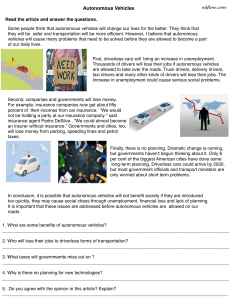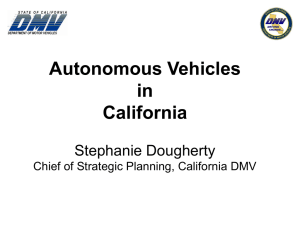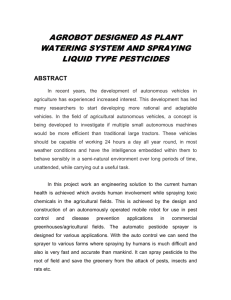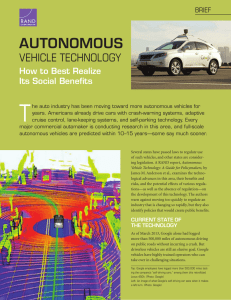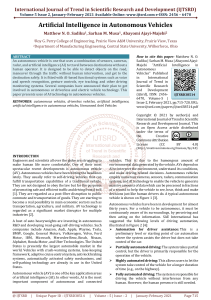driverless cars - the future of transport in cities?
advertisement
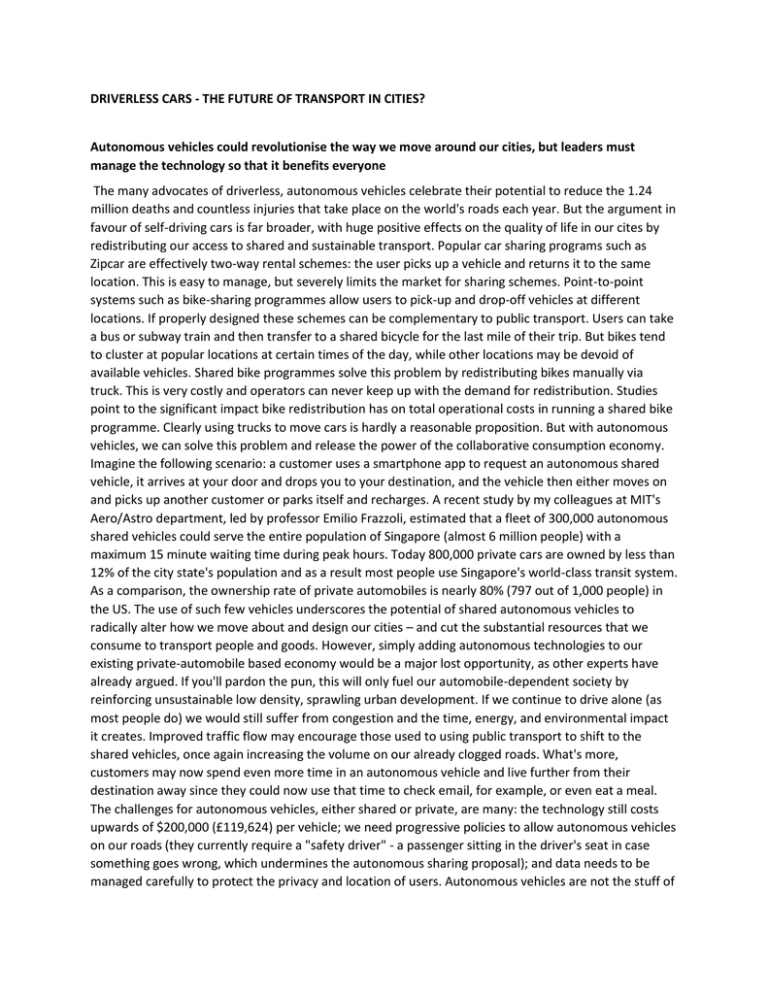
DRIVERLESS CARS - THE FUTURE OF TRANSPORT IN CITIES? Autonomous vehicles could revolutionise the way we move around our cities, but leaders must manage the technology so that it benefits everyone The many advocates of driverless, autonomous vehicles celebrate their potential to reduce the 1.24 million deaths and countless injuries that take place on the world's roads each year. But the argument in favour of self-driving cars is far broader, with huge positive effects on the quality of life in our cites by redistributing our access to shared and sustainable transport. Popular car sharing programs such as Zipcar are effectively two-way rental schemes: the user picks up a vehicle and returns it to the same location. This is easy to manage, but severely limits the market for sharing schemes. Point-to-point systems such as bike-sharing programmes allow users to pick-up and drop-off vehicles at different locations. If properly designed these schemes can be complementary to public transport. Users can take a bus or subway train and then transfer to a shared bicycle for the last mile of their trip. But bikes tend to cluster at popular locations at certain times of the day, while other locations may be devoid of available vehicles. Shared bike programmes solve this problem by redistributing bikes manually via truck. This is very costly and operators can never keep up with the demand for redistribution. Studies point to the significant impact bike redistribution has on total operational costs in running a shared bike programme. Clearly using trucks to move cars is hardly a reasonable proposition. But with autonomous vehicles, we can solve this problem and release the power of the collaborative consumption economy. Imagine the following scenario: a customer uses a smartphone app to request an autonomous shared vehicle, it arrives at your door and drops you to your destination, and the vehicle then either moves on and picks up another customer or parks itself and recharges. A recent study by my colleagues at MIT's Aero/Astro department, led by professor Emilio Frazzoli, estimated that a fleet of 300,000 autonomous shared vehicles could serve the entire population of Singapore (almost 6 million people) with a maximum 15 minute waiting time during peak hours. Today 800,000 private cars are owned by less than 12% of the city state's population and as a result most people use Singapore's world-class transit system. As a comparison, the ownership rate of private automobiles is nearly 80% (797 out of 1,000 people) in the US. The use of such few vehicles underscores the potential of shared autonomous vehicles to radically alter how we move about and design our cities – and cut the substantial resources that we consume to transport people and goods. However, simply adding autonomous technologies to our existing private-automobile based economy would be a major lost opportunity, as other experts have already argued. If you'll pardon the pun, this will only fuel our automobile-dependent society by reinforcing unsustainable low density, sprawling urban development. If we continue to drive alone (as most people do) we would still suffer from congestion and the time, energy, and environmental impact it creates. Improved traffic flow may encourage those used to using public transport to shift to the shared vehicles, once again increasing the volume on our already clogged roads. What's more, customers may now spend even more time in an autonomous vehicle and live further from their destination away since they could now use that time to check email, for example, or even eat a meal. The challenges for autonomous vehicles, either shared or private, are many: the technology still costs upwards of $200,000 (£119,624) per vehicle; we need progressive policies to allow autonomous vehicles on our roads (they currently require a "safety driver" - a passenger sitting in the driver's seat in case something goes wrong, which undermines the autonomous sharing proposal); and data needs to be managed carefully to protect the privacy and location of users. Autonomous vehicles are not the stuff of science fiction. The technology has existed for years and recent research has elevated the field from experiment to near-commercial readiness. Experts know this, but all interested parties have potentially conflicting goals. Visionary leaders in every sector – from government to industry and research – must act now, before autonomous vehicle technologies become inexpensive and ubiquitous, so that they can be managed for the greatest benefit to society. Ryan C.C. Chin is managing director and research scientist for the City Science Initiative at MIT Media Lab Join the community of sustainability professionals and experts. Become a GSB member to get more stories like this direct to your inbox
